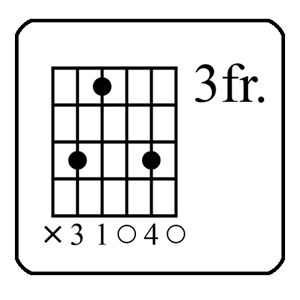This lesson explores adding open strings around common chord shapes. Several chord pattern examples are provided along with the general theory of how these chords are organized into progressions. A practice piece is also included as a part of the lesson plan…
OPEN STRING CHORD VOICINGS
Introducing chord voicings that add available open strings (playing open strings along with fretted chord notes) can create lush, wide open musical soundscapes.
One of the most enjoyable by-products of using an “open-string voicing” is how easy it can be to incorporate larger intervals into the chord voicing.
The sound of these larger chord tone distances tend to immediately add a unique statement to your music. If you’ve never tried it before, you might discover that you will have a new interest in this approach.
ADDING OPEN STRINGS TO CHORDS YOU KNOW:
Adding open strings into the mix of various fretted tones on the fingerboard can be made easier by simply doing nothing more that just experimenting.
Try adding open strings to some of the chords that you already know. Using this approach (as a simplified introduction to this technique), will allow you to maintain better awareness of the chord name and the chords quality.
For example, if you played a fifth position “D minor 7th,” chord, but you allowed for an open 3rd string to be introduced into the chord, this “new chord” would maintain the originals minor quality.
The open third-string “G” (introduced in the new open-string chord structure), would produce an extended quality chord type of, “Minor 11th.”

HARMONIZING WITH OPEN CHORD VOICINGS:
In order to compose songs in a particular key, it is important to be clear on the harmony of the key that you are working with.
Likewise, it is just as important to understand the use of possible modulations into other keys.
To do this effectively, you would of course require a solid understanding of key center harmony for both major and minor keys.
NOTE: For learning more information on the topic of Harmony, watch my video lesson on, Harmonizing the Major Scale. The “Intermediate Guitar Program” also covers this topic, but in far greater detail. The Intermediate curriculum also includes exercises for mastering the principles of harmonization.
CREATING CHORD PROGRESSIONS:
To incorporate open string voicings into progressions, you could take a harmony that is based off 5th and 6th string roots and begin incorporating open strings into some common the chords of the key signature.
For example, if you were harmonizing the key of, “C Major,” try adding open 3rd, 2nd or 1st guitar strings into various chords found in the harmonized scale.
Since the notes of, “G, B and E,” are all within the key of “C,” adding any of these open strings into the chord will allow the overall harmony to continue to function appropriately.
To test this principle, begin by learning the following chords, then apply them in the chord progression that follows…
“C” Major 7

“D” Minor (add2 /add4)

“E” Minor 7

“F” add2 (b5)

EXAMPLE CHORD PROGRESSION:

CONCLUSION:
Almost any chord played on the guitar can have open strings added into its structure. If the open string notes are a part of the key signature (diatonic), they will generally sound consonant (in balance).
If open strings are added to a chord which are not a part of that chords diatonic harmony, there is always a possibility for dissonance (tension). This is why it is always good to play your music for others when adding non-diatonic open strings into the structure of a chord. An extra set of ears never hurts.
Of course, in the end, everything comes down to how you personally feel about the sound of the chords you create. If things sound really cool, (or at least interesting), then you are more than likely on to something.
If an added open string creates a sour note, (and you find yourself cringe), then perhaps reconsider the open string choice.
When songwriting with this open string chord concept, the process may involve repeated modifications of your composed ideas. Try testing open string tones as you compose. Determine if the open strings “fit” your composition.
You might also try taking chord changes that you are already familiar with and use those ideas to begin testing open string options across your composition.
Understanding music theory can help a great deal. If you understand theory and you can name the chords that you create, you’ll better comprehend the structure of what you’re composing.
However, on a final note, playing by ear is a lot of fun too! So, regardless of how you test this open chord concept in your own playing, always keep an open mind and continue to experiment musically.
- Click the button below to download the lesson handout
(access to lesson material will require a FREE membership)
